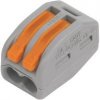Hi all!
I have recently completed my own e-MTB conversion and I have both a rack battery and a downtube battery. This is necessary as I am a courier for a living and do 8-10 hour shifts, sometimes more. The regular switching between batteries is leading to quite a fast degradation in the wires/terminals between batteries and the controller.
I am wondering whether there is some kind of a device or way to keep both batteries’ wires plugged in to the controller, but to be able to flick between which is active? I am guessing I need something which would be able to ensure that the battery that is off does not loop in with the rest of the circuit?
I am a rookie with electricals so any advice at all would be great and much appreciated.
I have included a picture of the terminals that I currently use.
Thank you,
Jermaine.
I have recently completed my own e-MTB conversion and I have both a rack battery and a downtube battery. This is necessary as I am a courier for a living and do 8-10 hour shifts, sometimes more. The regular switching between batteries is leading to quite a fast degradation in the wires/terminals between batteries and the controller.
I am wondering whether there is some kind of a device or way to keep both batteries’ wires plugged in to the controller, but to be able to flick between which is active? I am guessing I need something which would be able to ensure that the battery that is off does not loop in with the rest of the circuit?
I am a rookie with electricals so any advice at all would be great and much appreciated.
I have included a picture of the terminals that I currently use.
Thank you,
Jermaine.






